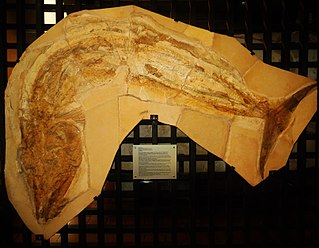Kentriodon is an extinct genus of toothed whale related to modern-day dolphins. Fossils have been found in North America, Europe and Japan. Several species have been described.
Salminops is an extinct genus of prehistoric bony fish that lived during the Cenomanian known from USA and Portugal.
Oshunia is an extinct genus of prehistoric bony fish that lived during the Albian. Fossils of the genus were found in the Romualdo Formation of the Araripe Basin, northeastern Brazil. Other authors assign a Cenomanian age to the fish.
Aphnelepis is an extinct genus of prehistoric freshwater ray-finned fish that lived during the Late Jurassic epoch. It contains a single species, A. australis, from the Talbragar River beds of New South Wales, Australia.
Ioscion morgani is an extinct prehistoric bony fish that lived during the Upper Miocene subepoch of what is now Southern California. It is primarily known from incomplete fossils, such as the holotype, which consists of a broken backbone. Although the head is unknown, enough of the animal's anatomy suggests a relationship with the jackfishes of Carangidae.

Chalcidichthys is an extinct genus of prehistoric manefish. It contains a single species, C. malacapterygius, that lived during the Upper Miocene of Southern California. It is known from the Modelo Formation in Los Angeles County, and specimens were found during construction of a tunnel on Sepulveda Boulevard. It is assumed to have preyed on siphonophores, like its living relatives.

Lophar miocaenus is an extinct bony fish almost identical in form to the living bluefish, Pomatomus saltatrix, differing in its dentition, which consisted of "thick, conical subequal teeth" instead of the sharp, slender teeth and canines seen in bluefish. L. miocaenus lived during the Upper Miocene subepoch of Southern California.
Styracopterus is an extinct genus of prehistoric bony fish that lived during the Tournaisian stage of the Mississippian epoch of Scotland and Eastern European Platform, Russia.
Cheirodopsis is an extinct genus of prehistoric marine ray-finned fish that lived during the Viséan stage of the Mississippian epoch. It contains a single species, C. geikiei from what is now Glencartholm, Scotland.
Cosmoptychius is an extinct genus of freshwater and estuarine ray-finned fish that lived during the Mississippian epoch. It contains a single species, C. striatus from the Visean of Scotland. It has a wide stratigraphic range in the Wardie Shale, with many specimens known.
Opsithrissops is an extinct genus of prehistoric bony fish that lived during the Thanetian stage of the Paleocene epoch. It is a 120 centimetres (3.9 ft) fish in the family Osteoglossiformes which includes other bony-tongues such as the extant species of arowana and arapaima.
Cyttoides is an extinct genus of prehistoric marine ray-finned fish that lived during the early Oligocene epoch in the seas over Europe. It contains a single species, C. glaronensis from Canton Glarus, Switzerland. It was a zeiform related to the extant genus Cyttus.

Asthenocormus is an extinct genus of large marine pachycormiform ray-finned fish. It contains a single species, A. titanius. A member of the edentulous suspension feeding clade within the Pachycormiformes, fossils have been found in the Upper Jurassic plattenkalks of Bavaria, Germany.
Euporosteus is an extinct genus of prehistoric sarcopterygian or lobe-finned fish.
Moenkopia is an extinct genus of prehistoric sarcopterygians from the Coelacanthidae found in the Middle Triassic Moenkopi Formation of Arizona. The type, and only species, M. wellesi, was named in 1961 in honour of Samuel Paul Welles. It is only known from the holotype, UMCP 36193, a partial skull consisting only of the basisphenoid that was collected in 1939 or 1940 by Samuel Welles and briefly noted on by him in 1947, and other assorted specimens found before 2005 in the Radar Mesa by S. J. Nesbitt, W. G. Parker and R. B. Irmis.
Ceramurus is an extinct genus of prehistoric marine ray-finned fish from the Late Jurassic. It contains a single species, C. macrocephalus from the Purbeck Group of England.
Strepheoschema is an extinct genus of prehistoric bony fish that lived during the early Mississippian (Tournaisian–Visean) in what is now Berwickshire, Scotland, and Northumberland, England. Fossils were recovered from the Ballagan Formation.

Mimipiscis is a fossil genus of very primitive ray-finned fishes from the Upper Devonian Gneuda and Gogo formations of Western Australia.

Phanerosteon is an extinct genus of prehistoric bony fish from the Carboniferous period. The type species, P. mirabile, was recovered from the Calciferous sandstone series (Pennsylvanian), Scotland. A second species, P. phonax was described from the Serpukhovian aged Bear Gulch Limestone lagerstätte in Montana, United States.

Tarasiiformes is an extinct order of prehistoric ray-finned fish.






